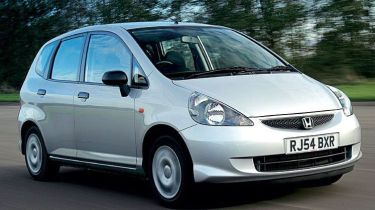Honda Jazz Hatchback review
.

There are newer and cheaper superminis, but the soon to be replaced Honda Jazz still sets the standard in the class for build quality, low running costs and versatility.
Styling/Image
You’d struggle to call the Jazz stylish, but its simple and upright shape is a classic example of form following function. The range-topping Sport attempts to enhance the plain looks by adding a neat bodykit comprising a deeper front bumper and side skirts. Plump for the SE and you get body colour mirrors and alloy wheels, while the entry-level S makes do with plastic wheel trims.
Interior/Practicality
One of the Jazz’s strongest selling points is its versatile interior. By relocating the fuel tank, Honda’s engineers have freed up room beneath the rear bench, which enables it to either fold flat or up and out of the way against the front seats. Elsewhere, the cabin is solidly built and packed with oddment stowage. The 1.2 S gets electric windows and twin airbags, while the SE adds air-conditioning. Go for the Sport and you’ll be rewarded with a multi-function wheel, remote locking and climate control
Engine/Performance
With only two petrol engines on offer there’s not much in the way of choice. The 76bhp 1.2-litre i-DSI is only available in basic ‘S’ specification. The SE and Sport versions get the 82bhp 1.4-litre i-DSI, which offers only a small boost in performance. Both units are capable of at least 48mpg, while the larger powerplant can be fitted with a CVT automatic gearbox that gets seven ‘virtual’ ratios. A diesel engine is in the pipeline for the all-new Jazz that’s set to appear late in 2008.
Driving experience
With direct steering and keen turn-in, the Jazz is great fun to thread through a series of bends. Sadly, the ride is less impressive, as it can become choppy over bumpy roads. Honda’s CVT automatic gearbox is much better than similar systems offered by rival manufacturers and is money well spent if an automatic is a must. It has three modes: ‘D’ for cruising, ‘S’ for swifter changes and ‘7-speed’ for F1-style semi-auto shifts via steering wheel mounted buttons.
Ownership Costs
Low running costs are part and parcel of the Jazz ownership experience. Fuel economy is excellent on both versions, while service intervals of 12,500 miles help keep maintenance bills to a minimum. Further incentives include a low insurance grouping and retained values that are among the highest in the class. However, even the 1.2-litre engined model falls into VED Band B, meaning an annual tax bill of at least £120.
Safety/Environment
All models have anti-lock brakes and twin front airbags, but you’ll have to go for either the SE or Sport if you want standard side bags. Sadly, stability control isn’t available, even as an option. Fortunately, Isofix seats, ABS, Brake Assist, EBD and seatbelt pre-tensioners are fitted to all versions. Finally, while a four-star Euro NCAP rating is no longer class leading, it is respectable for a car that was launched seven years ago.
Our Choice: 1.4 SE







